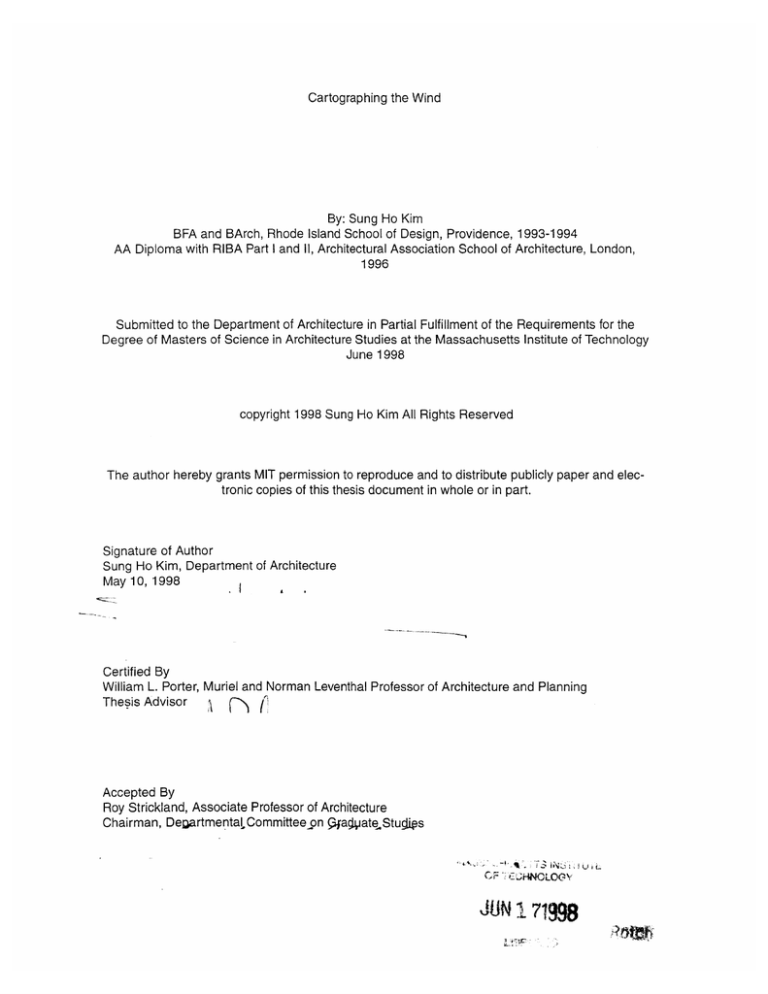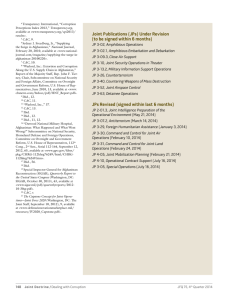
Cartographing the Wind
By: Sung Ho Kim
BFA and BArch, Rhode Island School of Design, Providence, 1993-1994
AA Diploma with RIBA Part I and II, Architectural Association School of Architecture, London,
1996
Submitted to the Department of Architecture in Partial Fulfillment of the Requirements for the
Degree of Masters of Science in Architecture Studies at the Massachusetts Institute of Technology
June 1998
copyright 1998 Sung Ho Kim All Rights Reserved
The author hereby grants MIT permission to reproduce and to distribute publicly paper and electronic copies of this thesis document in whole or in part.
Signature of Author
Sung Ho Kim, Department of Architecture
May 10, 1998
1
Certified By
William L. Porter, Muriel and Norman Leventhal Professor of Architecture and Planning
Thesis Advisor
Accepted By
Roy Strickland, Associate Professor of Architecture
Chairman, DeaartmentalCommitteeon pagaVateStucips
CF TECHNOLOGY'
dUm1I71998
Reader
Edith K.E. Akermann
Visiting Professor, Department of Architecture
Reader
Micheal Leja'
Associtte Professor of TIhe History of Art
Reader
Robert T. O'Neal
Professor of Industrial Design, Rhode Island School of Design
Cartographing the Wind
By: Sung Ho Kim
Submitted to the Department of Architecture on June 10, 1998 in Partial Fulfillment of the Requirements for the Degree for Masters of Science in Architecture Studies
Abstract
At the beginning of the design process the architect possesses only a random collection of information, requirements, intentions, and assumptions, and then suddenly on the drawing board
appears a proposal for an architectural form. How is this idea generated, what influences its
shape, from what is it derived from?
Faced with the daunting task of conceiving a building form, should one first study the functional
requirements, or manipulate geometrical systems, or give expression to inner intuitions? During
this critical stage of creating something out of nothing, architects desire a set of normative principles that could guide their activities. Many theories about the source of form were developed to
help govern architectural practice, and much practice derived from these theories.
This question about the source of form is equally central to theories in other fields from art and
architectural history to anthropology. However these other fields are not concerned with creating
architectural forms, but are attempts to explain the social, cultural, and historical phenomena
which are manifested in the built environment.
Today we must acknowledge that any new form of architecture not only has to rethink the specific
forms it produces, but, as a condition for doing so, has to rethink the form, shape, and articulation
of its practice of architecture. Henri Focillon suggests that all of life, has a certain shape, a certain
form that is the result of its affiliations and intermingling with other forms. It is in the shaping of the
form of practices including techniques, investigations, operations, perceptions, and logics, that the
new architectural form prevail.
Cartographing the wind is a research into an invention of new architectural practice. By experimenting and developing the analysis\ design of an enveloping architecture capable of reconfiguring and mapping aerodynamic spectram around the object. Sophisticated configuration of
programs emerge to respond with complex order to determine and redefine the new limits of our
condition of architectural experience.
Like a net, a map does not simply describe what is. A map does not only set up a grid which determines what can be found by selection or omission. Nor is it merely a series of lines inscribed on a
blank surface. There is an alterity which provokes the desire to map, to contain and to representwhich is to say, to embody or to embrace the unknown. Cartographing the Wind focuses on the
shift from the fixed static notions of architecture to dynamic formations. The mapping of the nonlinear dynamics in wind forces transforms and destabilizes classical perceptions of space, geometry, program, and universality.
Thesis Advisor
William L. Porter
Muriel and Norman Leventhal Professor of Architecture and Planning
Contents
Introduction
page 7
Desire for Scientific Representation
page 9
Philosophy/Representation
page 15
Cartographing the Wind
page 17
Conclusion
page 37
Bibliography
page 41
Fig. 1: Chronophographic studies of wind movements
5
4f
Fig. 2: Photographs of wind flows, viscosities, and vortices
Introduction
Architects consider architectural representations in terms of fixed norms of traditional and classical
descriptions of planar, elevational, and sectional relations. If the focus is shifted from the static
techniques to dynamic (time and movement based) systems, a new horizon of possibilities
unfolds. Time and movement appear in the world as something tangible and empirical experience,
as a destabilizing but creative force. Therefore, a corresponding shift is necessary from the fixed
static geometry of classicism to a new language of flows, viscosities, and vortices. This shift transforms unclassical notions, perceptions, and universality.
Manuel DeLanda calls temporal / material fluxes the figures of destiny, "which are singular incarnations of order whose lineaments come into being momentarily; as such they are not distant, prior to
or above the material conditions that spawned them."1 An even more disordered, but sophisticated
universal structure emerges: a dynamic architectural representation that has no essential origin
and is incarnated in multiple languages, formations, and regimes. The important value of the techniques developed in Cartographing the Wind lies not in a capacity of representation, but rather in
its latent potential as the tool for investigation. The non-linear dynamics found in wind forces are
charted at the level of order and can be instrumental archtecturally. Cartographing the Wind is a
complete engagement with scientific procedures. This is neither a metaphor nor a symbol, but a literal employment of the order itself.2
1. Jesse Reiser, "Newsline", Solid State Architecture, Spring, 1998, p. 7.
2. Ibid.
----------
&
Ai
e
-,
9-A.f
411fl.
i'm'
V9
...
.. ....
Fig. 3: Louis Kahn's urban movement diagram
t
Desire for Scientific Representation
"Resemblance makes a unique assertion, always the same: This thing, that thing, yet another
thing is something else. Similitude multiplies different affirmations, which dance together, tilting
and tumbling over one another."
Michel Foucault
Michel Foucault asserts, similitudes impose an important bearing on an "original" that any "copy"
renders in an imperfect manner. With resemblance there is no ultimate reference point. The representational relations are symmetric and can be reversed and extended without limit. Each item in a
network is a "graphism that resembles only itself." Convergence, and not the inherent characteristics of an "original", provides the material substance for the disclosure of similitudes. An art that
makes similitude explicit is not different from representation by resemblance. It uncovers a common ground that is hidden in representational realism and thereby states the importance of similitude over resemblance. Resemblance is a product of "illusionist" technique while similitude is an
inescapable resource in textual representation. Hence, to analyze representation is to uncover the
conjurer's tricks through which chains and networks of similitude are laboriously built-up and then
1
"forgotten" in the assumed sufficiency of their reference to an "original".
In scientific representation, resemblance and similitude are inadequate. "Mere" metaphor, similarity, or surface resemblance are to be discarded in support of deep "genetic", or "mathematical"
reconstructions of a phenomenon's organization. It is not enough to represent the object; it needs
to be dissected by theory and opened up to an active manipulation of its principles of form. Scientists describe, depict, and record by utilizing the full spectrum of literary techniques of representations: drawings, graphs, photos, diagrams, etc. provide distinctive formats, referential uses, and
1. Michael Lynch and Steve Woolgar, Representation in Scientific Practice, p. 7.
A
-.
Fig. 4: Working drawing of a locomotive
A MI 1x 11
Fig. 5: Drawings of drafting instruments
4
.Lf
iterable and analyzable traces. The representation allows a visual construct of an unseen phenomenon.1
In Foucault's Discipline and Punish, he illustrates the shift from a power which is seen by invisible
onlookers, to a new visible power that sees everything about everyone. The important aspect of
Foucault's analysis is not only to capture individual records on files, accounting books, and time
charts, but also to locate them in the institutions in which these inscriptions and representations
are being utilized. Foucault's panopticon allows authority for penology, pedagogy, psychiatry, and
clinical medicine to develop as sciences from their institutional inscriptions. The panopticon is
another method of reaching the "optical consistency" required for gaining power on a larger scale.2
"Optical Consistency" is obtained in geology by the invention of new visual representation. Without
representation the layers of the earth stay hidden no matter how many explorers and miners
maneuver the terrain; there is no way to share their travels, visions, discoveries, and claims. 3
Immanuel Kant states, "We shall be rendering a service to reason should we succeed in discovering the path upon which it can securely travel." The Copernican Revolution, sympathetic to Kant,
illustrates a simple mechanism: if we cannot go to the earth, let the earth come to us, or, more
accurately, let us all go to many places on the earth, and come back with similar but different pictures, that can be gathered, compared, superimposed, layered, and retraced as a celebration of
our newly obtained knowledge. 4
Peter Booker explains that linear perspective progressively "changed the concept of pictures from
being just representations to that of their being projections onto planes". The perspective still
1.
2.
3.
4.
Ibid.
Ibid., p. 37.
Ibid.
Ibid.
depended on the viewer's position and the objects could not be moved without perspectival mutation. Desargue's work on descriptive geometry assisted in re-inventing the "point of view" or mental
way of looking at things. In place of the imaginary lines of space difficult to perceive which were the
fundamental basis of perspective at that time, projective geometry allowed perspective to be rendered in terms of solid geometry. With the invention of descriptive geometry, the viewer's position
becomes irrelevant. "It can be viewed and photographed from any angle or projected onto any
plane that is, distorted and the result remains true."i
Booker describes how a few engineers could master enormous machines that did not exist yet.
These feats can not be imagined without industrial drawings. Booker, quoting an engineer,
describes the change of scale that allows the few to dominate the mass. "A machine that has been
drawn is like an ideal realization of it, but in a material that costs little and is easier to handle than
iron or steel.... If everything is first well thought out, and the essential dimensions determined by
calculations or experience, the plan of a machine or installation of machines can be quickly put on
paper and the whole thing as well as the detail can then most conveniently be submitted to the
severest criticism.... If at first there is doubt as to which of various possible arrangements is the
most desirable then they are all sketched, compared with one another and the most suitable can
2
easily be chosen."
Industrial drawings allow the paper world to manipulate the three dimensional world. They create a
common ground for other inscriptions to bond together. Margins of tolerance can be annotated on
the drawing, the drawing can be used for directing the task to be achieved, for economic calculation, or for structuring the repairs and the sales. "The drawing's importance lies not only in planning, but in execution because the measurements and proportions of all the components are
1. Ibid., p. 52.
2. Ibid., p. 53.
sharply and definitely determined from the beginning. During the manufacturing it is only necessary to imitate in the materials used for construction exactly what is shown on the drawing."i
The realms of reality that seem distant (mechanics, economics, and scientific organizations) are
only inches apart, once flattened out onto the same surface. The accumulation of drawings in an
"optically consistent" space is the universal basis that allows work to be planned, deployed, and
realized. 2
Foucalt, Kant, and Booker acknowledged the importance of "optical consistency", which provided
the material and language for the development of visual and conceptual empowerment.
1. Ibid., p. 54.
2. Ibid.
Fig. 6: Diagram of Desargue's theory
V
Y
A
Fig. 7: Drawing of Descartes in the Dioptrics
Fig. 8: Diagram of Charles Peirce on logic of continuity
Philosophy/Representation
To Ludwig Wittgenstein, the traditional task of philosophy is to clarify propositions and impede
1
knowledge from being led astray by the misleading appearances of everyday language.
For pragmatists, the perception is linked to a filter which selects, simplifies, and orders the chaotic
world according to the perceiver's experience. This image was used to describe the operations of
2
the individual "mind" or "consciousness" confronted with phenomenological stimuli.
"Human mind, and also the sense-organs and even all organic life, is a selective agency. Owing to
their selective activity, the sense-organ filters the physical stimuli by which they are excited. By a
subsequent selection, those sensations which serve as signs of things are shifted from the totality
of experienced sensations. Selection is responsible for the constancy- phenomena: rhythm into a
monotonous succession of sonorous strokes, it groups dispersed dots into rows, figures, and constellations. Whatever organization may be found in experience is bestowed upon it by the mind
3
working on primordial chaos of sensation."
Even in philosophy, visual representation and dynamic modeling (creating scenarios in which a
phenomenon can unfold), are employed to transcend the limitations of our everyday language, and
pave the way for a clarified diagrammatic theory. A shift from description to visualization, from
graphic inscription to imaginary projection, or simulation prevail the depth of our perception.
1. Lynch and Woolgar, p. 10.
2. Ibid., p. 155.
3. Ibid.
Fig. 9: Photographic breakdown of bird in flight
Fig. 10: Bronze sculpture of a bird in flight
Cartographing the Wind
The invention of photography, Benjamin explains, "became all the greater as, in the light of the new
technical and social reality, the subjective contribution to painted and graphic information was seen
to be increasingly questionable." Photography uncovered both traces of time and space, constructing the perception of dynamic movements.
Cartographing the Wind deploys photographing and mapping (techniques) as the modes of scientific investigation. The juxtaposition of both photography and map transforms the material to be
represented in the mapping procedure.
The diagrammatic mapping technique is a schematic representation of a photograph. The techniques (photographing and mapping) have a directional relationship to one another: each is an
independent representation, but they are not interchangeable operations. One depends upon the
other: the map operates upon the photograph. The map is the schematic reading of the photograph, but the photograph is not a schematic representation of the diagram. The techniques display a sequential ordering; the photograph being an "original" and the map a rendering of it.
Mapping is the "reduction" of the photograph, a simplification that is congruent with the didactic
and representational purposes of the respective text in which it materializes. The photograph is the
"original" material and the map is descriptively analyzed, labeled, and idealized. 2
A map is what Martin Heidegger calls "the mathematical" in the sense of masseuses universalis:
the theoretical domain of pure structure and universal laws which a Galilean science treats as the
foundation of order in the world. The photograph conveys the unique, situationally specific, per
1. Walter Benjamin, Charles Baudelaire A Lyric Poet in the Era of High Capitalism, p.162
2. Lynch and Woolgar, p. 160.
/1
K
I
r
)
Fig. 11: Long exposure photograph of bird in flight
Figs. 12-13: Etienne-Jules Marey's movement diagrams
oscillation of human and horse
-
*12
1
5
14
P"I
VU
4
Fig. 14: Eadweard Muybridge's Diagrammatic analysis of the stride of a horse
17
spectival, instantaneous, and particular aspects of the object while the map brings into the relief
the essential, synthetic, constant, and present aspects of the object itself. The map is not simply
an ideal image while the photograph is empirical. Both photograph and map operate on a common
textual surface, and depend upon the artifices of inscription and interpretation while representing
the object in its spatio-terminal dynamic. It is in this multiple reading that the map leans on mathematical direction more than the photograph.1
Maps depict a continuum of representations modifying the products of previous observations and
representations. These representations specify prior information exhibiting a territory of pre-established formations already visible. At the same time, the map upgrades the orderliness and utility of
the formations. Order is not simply stated, it is exposed, seized, clarified, extended, coded, com2
pared, measured, and subjected to mathematical operations.
For Edmund Husserl, mathematization was a historical accomplishment. He analyzed the accomplishment not as a development in factual history, but as a retrospective implication of "internal history". Husserl's historical reflections started with the intuitively mis-processing mathematical
sciences. From that shifting point, Husserl programmatically defined the problems of things
encountered in a pre-scientific praxis measured by and identified with the forms of geometry. "First
to be singled out from the thing-shapes are surfaces more or less "smooth", more or less perfect
surfaces; edges, more or less rough or fairly "even"; in other words, more or less pure lines,
angles, more or less perfect points; then, again, among the lines, for example, straight lines are
especially preferred, and among surfaces the even surfaces, straight lines, and points are preferred, where as totally or partially curved surfaces are undesirable for many kinds of practical
interests. Thus the production of even surfaces and their perfection (polishing) always plays a role
in praxis."3
1. Ibid., p. 162.
2. Ibid., p. 163.
3. Ibid., p. 169.
M
1:2
2:3
30*4
Diagrammatic graphic notations of vibrations
The forms of geometry, initially used as points or lines of calculation for informing constructive
action, were cognitively transformed into the basis for a Galilean physics; a physics that assumed
mathematical order to be the essential underlying nature of the empirical world.'
The techniques of representation employed in Cartographing the Wind are more than artistic
instruments. They take their authority from previous experience and the state of the scientific field
to experimentally build on a body of assumptions about the represented phenomenon of the wind
force.
1. Ibid.
Fig. 16: Drawing of a Vitruvian man grafted with mathematical graphics
-4
Fig. 17: Newtonian and Modernists' representation of the universe
Conclusion
The scientific, mathematical, and philosophical entertainments that prevailed during the eighteenth
century inspired the methods of experiencing science. These recreations illustrated popular books,
optical cabinets, intricate machines, astonishing experiments, and provocative museum displays
contributed to the popularity of the public education. 1
Today old traditions of representations are being challenged and replaced by high-tech tools and
programs: Windows NT, AUTO CAD, Alias, Photo Shop, and Form Z. The use of the electronic
media reconfigures the print culture, as well as the histories of art and science on which these disciplines are grounded. 2
The use of computer graphics and interactive techniques demonstrate the returning of an oralvisual culture. Animation, virtual reality, fiber-optic video, laser disks, computer modeling, and emailing are part of a new visionary art-science. 3
In the research for representation, the traditional fields studying the development and techniques
of representation have to merge with the ongoing inquiry into dynamic visualization techniques. In
reflection of the present electronic upheaval, the historical knowledge of images must form part of
a continuum looking at the production, function, and meaning of every kind of perception. 4
"The purpose of this pseudo-scientific surgical procedure is to rid of its habitual baggage by
attempting to induce a state of indeterminacy." Marcel Duchamp's description of "The Large Glass"
questions the desire for scientific representation and its potential ability for unfolding unknown
1.
2.
3.
4.
Barbara Stafford, Artful Science, p. 2.
Ibid.
Ibid.
Ibid.
X70
00
O P
0
Q99
1
V
'i
4
Nt
k,
Fig. 18: Marcel Duchamp's working drawing of The Large Glass
'I,,
'*~
-
I
%
Fig. 19: David Marr's Computer drawings. Today we can not escape the power of scientific graphics. The domination of computers and their languages (C++ and Java) have projected a visual
blindness that can only be translated as the desire for scientific representations.
knowledge. 1 Duchamp, witty and obscure in his art, provokes the imperative role of science in
everyday life situations.
In the mist of modernity, Walter Benjamin describes, "the intricate combination of the passions
mecanistes with the passion cabaliste, were primitive analogies based on the machine, formed in
the material of psychology. This machinery, formed of men, produced the land of Cockaigne, the
primal wish- symbol, that Fourier's Utopia had filled with new life."2
In the world of industrial development, the social psyche was stimulated by the desire for mechanical imageries. Individuals and societies were shaped and influenced by optical consistency, the
images projected in multiple surfaces and places that begins to intergrade and affect the daily perception.
Today, the scientific representations are transformed by the use of computers and their system of
languages.Cybernetic and biological metaphors replace the mechanical imagerie. And dynamic
modeling and simulation techniques open new venues for visualizing and manipulating hidden
events. In a digital world, graphics do not merely signify, describe, or represent.They "behave", carrying out entire sequences of operations that could only be stated through descriptions. These
graphics have projected and embodied a visual foundation that can only be understood as the
desire to bring to life or "animate" earlier forms of scientific representations.
1. Natalija Subotinac, "World of Visual Indifference", Chora 1, p. 221.
2. Benjamin, p.160.
Bibliography
Ackerman,James. Distance Points. Cambridge: MIT Press, 1995.
Benjamin,Walter. A Lyric Poet in the Era of High Capitalism. New York: Verso, 1969.
Bergson,Henri. Matter and Memory. New York: Zone Books, 1991.
Cache,Bernard. Earth Moves. Cambridge: MIT Press, 1995.
Dagog net, Francois. A Passion for the Trace. New York: Zone Books, 1992.
Deleuze,Gilles. Bergsonism. New York: Zone Books, 1991.
Deleuze,Gilles. The Fold. Minneapolis: University of Minnesota Press, 1993.
Deleuze,Gilles, and Guattari,Felix. A Thousand Plateaus. Minneapolis: University of Minnesota
Press, 1987.
Derrida,Jacques. Edmund Husserl's Origin of Geometry. Lincoln: University of Nebraska Press,
1962.
Dewey,John. Art as Experience. New York: Perigee Books, 1934.
EvansRobin. The Projective Cast. Cambridge: MIT Press, 1995.
Focillon,Henri. The Life of Forms in Art. New York: Zone Books, 1992.
Gelernter,Mark. Sources of Architectural Form. New York: Manchester University Press, 1995.
Kant,lmmanuel. Critique or Pure Reason. New York: ST Martin's Press, 1965.
Karatani,Kojin. Architecture as Metaphor. Cambridge: MIT Press, 1995.
Lynch, Michael and WoolgarSteve. Representation in Scientific Practice. Cambridge:MIT Press,
1990.
Lefebvre,Henri. The Production of Space. Cambridge: Blackwell Publishers, 1974.
Panofsky,Erwin. Perspective as Symbolic Form. New York: Zone Books, 1991.
Riley,Patrick. Leibniz' Jurisprudence Universal. Cambridge: Harvard University Press, 1996.
Smith,Colin. Phenomenology of Perception M. Merleau-Ponty. London: The Humanities Press,
1962.
de Sola-Morales,lgnasi. Differences. Cambridge: MIT Press, 1996.
Strafford, Barbara. Artful Science. Cambridge: MIT Press, 1994.
Subotinic, Natdlija, An Excursion into the World of Visual Difference,Montreal:McGill Press, 1994.
Wild,John. The Crisis of European Sciences and Transcendental Phenomenology Edmund Husserl. Evanston: Northwestern University Press, 1970.






